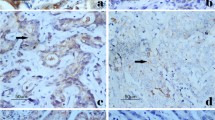Abstract
Background
Gastric cancer is the fourth most common cancer and the second leading cause of cancer-related deaths worldwide. Gastric cancer is characterized by high levels of invasion and metastasis. Increasing attention is being focused on discovering molecular markers for the diagnosis of gastric cancer and for predicting its prognosis. The objective of the present study was to evaluate Nurr1 expression in gastric cancer and to assess its correlation with clinicopathological parameters and prognosis in gastric cancer patients.
Methods
Tissue samples were obtained from 120 gastric cancer patients. We investigated Nurr1 expression in human normal and gastric cancer tissues using real-time reverse transcription polymerase chain reaction (qRT-PCR), western blotting, and immunohistochemistry. We determined the association between Nurr1 and recurrence, prognosis and patient clinicopathological parameters. Univariate and multivariate survival analyses with a Cox’s proportional hazards regression model were used to identify independent factors related to recurrence and prognosis.
Results
The immunohistochemical, qRT-PCR and western blot analyses revealed that Nurr1 expression was increased in gastric cancer tissues compared with normal gastric tissue (P < 0.05). Nurr1 expression was significantly correlated with the tumor size, depth of tumor invasion, lymph node metastasis, recurrence, and distant metastasis of gastric cancer (P < 0.05). Moreover, Nurr1-high patients also exhibited poorer overall survival (OS) and disease-free survival compared with Nurr1-low patients (P < 0.01). The univariate and multivariate survival analyses suggested that Nurr1 expression (P = 0.011), histology (P = 0.018), depth of tumor invasion (P = 0.037), and presence of lymph node metastasis (P = 0.031) were independent prognostic factors for recurrence. In addition, Nurr1 expression (P = 0.007), depth of tumor invasion (P = 0.014), lymph node metastasis (P = 0.044), distant metastasis (P = 0.023), and recurrence (P = 0.011) were independent prognostic factors of OS in gastric cancer patients.
Conclusions
The Nurr1 protein may be useful as a marker of recurrence, metastasis, and poor prognosis following curative resection in patients with gastric cancer.



Similar content being viewed by others
References
Bertuccio P, Chatenoud L, Levi F, Praud D, Ferlay J, Negri E, et al. Recent patterns in gastric cancer: a global overview. Int J Cancer. 2009;125(3):666–73.
Bosetti C, Bertuccio P, Malvezzi M, Levi F, Chatenoud L, Negri E, et al. Cancer mortality in Europe, 2005–2009, and an overview of trends since 1980. Ann Oncol. 2013;24(10):2657–71.
Ferro A, Peleteiro B, Malvezzi M, Bosetti C, Bertuccio P, Levi F, et al. Worldwide trends in gastric cancer mortality (1980–2011), with predictions to 2015, and incidence by subtype. Eur J Cancer. 2014;50(7):1330–44.
Ferlay J, Shin HR, Bray F, Forman D, Mathers C, Parkin DM. GLOBOCAN 2008 v2.0, Cancer incidence and mortality worldwide: IARC Cancer Base No. 10. http://globocan.iarc.fr, 2010. Accessed 15 June 2013.
Shen L, Shan YS, Hu HM, Price TJ, Sirohi B, Yeh KH, et al. Management of gastric cancer in Asia: resource-stratified guidelines. Lancet Oncol. 2013;14(12):e535–47.
Sekiguchi M, Suzuki H, Oda I, Abe S, Nonaka S, Yoshinaga S, et al. Risk of recurrent gastric cancer after endoscopic resection with a positive lateral margin. Endoscopy. 2014;46(4):273–8.
Wallén A, Zetterström RH, Solomin L, Arvidsson M, Olson L, Perlmann T. Fate of mesencephalic AHD2-expressing dopamine progenitor cells in NURR1 mutant mice. Exp Cell Res. 1999;253(2):737–46.
Llopis S, Singleton B, Duplessis T, Carrier L, Rowan B, Williams C. Dichotomous roles for the orphan nuclear receptor NURR1 in breast cancer. BMC Cancer. 2013;13:139.
Inamoto T, Czerniak BA, Dinney CP, Kamat AM. Cytoplasmic mislocalization of the orphan nuclear receptor Nurr1 is a prognostic factor in bladder cancer. Cancer. 2010;116(2):340–6.
Wang J, Yang J, Zou Y, Huang GL, He ZW. Orphan nuclear receptor nurr1 as a potential novel marker for progression in human prostate cancer. Asian Pac J Cancer Prev. 2013;14(3):2023–8.
Holla Vijaykumar R, Mann Jason R. Qiong. Prostaglandin E2 regulates the nuclear receptor NR4A2 in colorectal cancer. J Biol Chem. 2006;281(5):2676–82.
Nomura E, Lee SW, Bouras G, Tokuhara T, Hayashi M, Hiramatsu M, et al. Functional outcomes according to the size of the gastric remnant and type of reconstruction following laparoscopic distal gastrectomy for gastric cancer. Gastric Cancer. 2011;14(3):279–84.
Deutsch AJ, Angerer H, Fuchs TE, Neumeister P. The nuclear orphan receptors NR4A as therapeutic target in cancer therapy. Anticancer Agents Med Chem. 2012;12(9):1001–14.
Wang J, Yang J, Li BB, He ZW. High cytoplasmic expression of the orphan nuclear receptor NR4A2 predicts poor survival in nasopharyngeal carcinoma. Asian Pac J Cancer Prev. 2013;14(5):2805–9.
Inamoto T, Czerniak BA, Dinney CP, Kamat AM. Cytoplasmic mislocalization of the orphan nuclear receptor Nurr1 is a prognostic factor in bladder cancer. Cancer. 2010;116(2):340–6.
Boakye CH, Doddapaneni R, Shah PP, Patel AR, Godugu C, Safe S, et al. Chemoprevention of skin cancer with 1,1-Bis (3′-indolyl)-1-(aromatic) methane analog through induction of the orphan nuclear receptor, NR4A2 (Nurr1). PLoS ONE. 2013;8(8):e69519.
Zhang T, Wang P, Ren H, Fan J, Wang G. NGFI-B nuclear orphan receptor Nurr1 interacts with p53 and suppresses its transcriptional activity. Mol Cancer Res. 2009;7(8):1408–15.
Imam SZ, Jankovic J, Ali SF, Skinner JT, Xie W, Conneely OM, et al. Nitric oxide mediates increased susceptibility to dopaminergic damage in Nurr1 heterozygous mice. FASEB J. 2005;19(11):1441–50.
Zhao D, Desai S, Zeng H. VEGF stimulates PKD-mediated CREB-dependent orphan nuclear receptor Nurr1 expression: role in VEGF-induced angiogenesis. Int J Cancer. 2011;128(11):2602–12.
Conflict of interest
There are no conflict of interests to disclose.
Author information
Authors and Affiliations
Corresponding author
Additional information
G. Zu is co-first author.
Rights and permissions
About this article
Cite this article
Guo, J., Zu, G., Zhou, T. et al. Clinicopathological significance of orphan nuclear receptor Nurr1 expression in gastric cancer. Clin Transl Oncol 17, 788–794 (2015). https://doi.org/10.1007/s12094-015-1305-z
Received:
Accepted:
Published:
Issue Date:
DOI: https://doi.org/10.1007/s12094-015-1305-z




